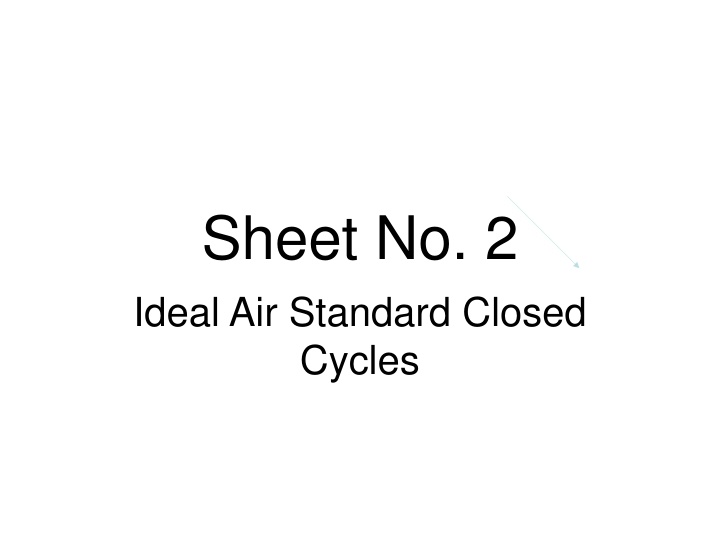
Thermodynamics and Ideal Air Standard Cycles
Explore the principles of Carnot for achieving high thermal efficiency, differences between ideal air-standard cycles and actual cycles, calculations for engine parameters, and more in the field of thermodynamics and ideal air standard cycles.
Download Presentation

Please find below an Image/Link to download the presentation.
The content on the website is provided AS IS for your information and personal use only. It may not be sold, licensed, or shared on other websites without obtaining consent from the author. If you encounter any issues during the download, it is possible that the publisher has removed the file from their server.
You are allowed to download the files provided on this website for personal or commercial use, subject to the condition that they are used lawfully. All files are the property of their respective owners.
The content on the website is provided AS IS for your information and personal use only. It may not be sold, licensed, or shared on other websites without obtaining consent from the author.
E N D
Presentation Transcript
Sheet No. 2 Ideal Air Standard Closed Cycles
1- What are the Carnot`s principals to get the highest thermal efficiency. 2- What is the thermal efficiency of an engine develops 22.4 kW and consumes 10.25 litres of fuel per hour, the calorific value being 46000 kJ/kg and the specific gravity 0.72. 2- Solution: Potential heat supplied per hour = 10.25 0.72 46 000 = 339 300 kJ. Since 1 W = 1 J/s, work done per hour = 22.4 60 60 = 79 950 kJ. The thermal efficiency = 79 950/339300 =23.6%
3- How an ideal air-standard cycle differs from the actual cycle? 3- Solution: An ideal air-standard cycle differs from the actual by the following: i- The gas mixture in the cylinder is treated as air (an ideal gas with constant specific heats) for the entire cycle treated as. ii- The real open cycle is changed into a closed cycle. iii- The combustion process is replaced with a heat addition. iv- The open exhaust process, which carries a large amount of enthalpy out of the system, is rep. laced with a closed system heat rejection process
4- In a certain engine the cross-sectional area of the piston crown is 80 cm2and the stroke length is 120 mm. The swept volume is: (a)9600 cm3 (b) 120 cm3 (c) 960 cm3 5- A certain engine has a swept volume of 400 cm3and a clearance volume of 50 cm3. Calculate the compression ratio. 6- A petrol engine operating on the Otto cycle has a compression ratio of 8:1. Given the adiabatic index for air = 1.4, calculate the air standard thermal efficiency.
7- A certain diesel engine has a compression ratio of 14:1. The fueling factor (cut-off ratio or load ratio) = 1.78. Calculate the air standard efficiency; take = 1.4. 8- A compression ignition engine operating on the dual combustion cycle has a compression ratio of 16:1. The cut-off ratio for this engine is 1.6 and the pressure ratio rp=1.2 . Calculate the ideal thermal efficiency of this engine and take = 1.4.
9- The pressure and temperature of air standard dual combustion cycle are given below, i. T1 = 290 K ii. P1 = 1.01 bar iii. T2 = 871.1K iv. T3 = 1087.5 K v. T4 = 1236.3 K vi. T5 = 429.3 K and ratio of compression is 16:1. Calculate the thermal efficiency for this dual cycle engine.
